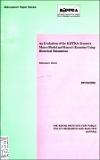| dc.description.abstract | Model simulations are perfonned for different reasons, such as policy evaluation,
historical policy analysis and model testing. Ex ante simulations tend to be
more popular, particularly for the purposes of evaluating policies before they
are implemented. Although there is less experience with ex post modeling,
simulations concerning the past are just as interesting as those concerning a
future period. The KIPPRA-Treasury Macro Model (KTMM) is a
macroeconomic model for the Kenyan economy and a vital tool in planning and
policy ·making process. It has been in operation since August 2000. After a
period of time, it is generally important to analyse the perfonnance of the model,
particularly in predicting specific variables. Using historical simulation analysis,
the paper evaluates KTMM in tenns of robustness of its predictive power and,
more importantly, provide a better understanding of the past structural economic
changes and policy regimes focusing on the period 1973-2003. The analysis
shows that most of the variables, such as levels of private investments and private
consumption, have been operating below their potential values, based on the
simulated trends depicted by the respective equations in the model, particularly
in the later years. The exchange rate simulations show a marked appreciation of
the Kenya shilling against the US dollar since the early 2000s. This has
implications for sectors like the export sector, which is key to spearheading
economic growth. The simulation analysis also shows that (total) wages in the
formal private sector increased significantly in the most recent period considered
(1998-2003). In general, there is potential for the economy to perform better
and what is needed are measures aimed at resuscitating the economy. | en |

